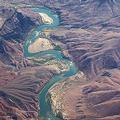 根一項針對925條大型河川所進行的河川流量新研究,許多在全世界人口最密集的一些區域裡的河川,其水流量正在慢慢流失。這項研究是由美國國家大氣研究中心(National Center for Atmospheric Research,NCAR)的科學家所引領,結果顯示降低的流量與氣候變遷有關,並且會威脅未來糧食與水的供應。
根一項針對925條大型河川所進行的河川流量新研究,許多在全世界人口最密集的一些區域裡的河川,其水流量正在慢慢流失。這項研究是由美國國家大氣研究中心(National Center for Atmospheric Research,NCAR)的科學家所引領,結果顯示降低的流量與氣候變遷有關,並且會威脅未來糧食與水的供應。
這些河川中,有一些輸送比以前少的水量,卻要供應給大量的人口,例如中國北方的黃河、印度的恆河(Ganges River)、西非的尼日河(Niger River)以及美國西南部的科羅拉多河(Colorado River)。
科學家們也發現相反的例子,也就是有更大的水流量流過人口零星分佈的北極海區域,這些地區的雪及冰正快速溶解中。
在科羅拉多州波爾德市「國家大氣研究中心」的科學家戴愛國(Aiguo Dai),同時也是此研究報告的主要作者表示:「逕流量減少讓全世界許多地方的淡水資源供應壓力升高,特別是當人口增加之後用水的需求也隨之增加。淡水是非常重要的資源,它的下降趨勢令人擔心。」
研究團隊在1948至2004年間進行河川流量的測量,並發現全世界1/3最大河川有流量顯著改變的現象。這些河川中,流量降低者的數量是流量增加者的2.5倍。
除了在南極與格陵蘭(Greenland)的河川之外,研究中其他河川的水,都是來自每個主要的陸塊,這些水佔全球河川總流量的73%。
戴愛國和他研究的共同作者將實際測量的河川流量與電腦模式所推算的河川流量進行合併,以填補資料間的差距。
他們從64年的入注水量研究中,發現每年流入太平洋的淡水量約減少6%(或約526立方公里),大致與密西西比河(Mississippi River)每年流出的水量相同。每年流入印度洋的水量大約減少3%(或約140立方公里),但是每年注入北極海的水量增加約10%,或約460立方公里。
科學家們表示,美國的哥倫比亞河在研究期間因為降水量減少以及西部用水量增多,因而流量下降約14%;然而,密西西比河在研究期間卻因為自1948年起中西部的降水量增加,因而流量增加22%。
此研究的作者們警告,雅魯藏布江及長江等部分河川顯示流量穩定或增加的現象,但是這些河川的流量也可能因為喜馬拉雅山冰河入注的水量逐漸消失,而在未來的幾十年內減少流量。
這個研究的共同作者,也是國家大氣研究中心科學家的淳恩柏(Kevin Trenberth)指出:「未來幾十年間,氣候變遷勢必持續進行,我們極有可能看見它對社會未來所依賴的許多河川及水資源造成更大的衝擊。」
影響河川水流出量有諸多因素,包括水壩的建設與農業及工業瓜分掉水量;然而這些研究者卻發現,在許多案例裡,流量的減少看起來與全球氣候變遷有關,氣候變遷改變降水模式並增加水的蒸發率。
Many of the greatest rivers in some of the world's most populous regions are losing water, according to a new study of stream flow in 925 large rivers. Led by scientists at the National Center for Atmospheric Research, the study indicates that the reduced flows are associated with climate change and could threaten future supplies of food and water.
Several of the rivers channeling less water serve large populations, such as the Yellow River in northern China, the Ganges in India, the Niger in West Africa, and the Colorado River in the southwestern United States.
By contrast, the scientists reported greater stream flow over sparsely populated areas near the Arctic Ocean, where snow and ice are rapidly melting.
"Reduced runoff is increasing the pressure on freshwater resources in much of the world, especially with more demand for water as population increases," says lead author Aiguo Dai a scientist with the National Center for Atmospheric Research in Boulder. "Freshwater being a vital resource, the downward trends are a great concern."
The research team examined stream flow from 1948 to 2004 and found significant changes in about one-third of the world's largest rivers. Of those, rivers with decreased flow outnumbered those with increased flow by a ratio of about 2.5 to 1.
The rivers in the study drain water from every major landmass except Antarctica and Greenland and account for 73 percent of the world's total stream flow.
Dai and his co-authors combined stream flow measurements with computer-based stream flow models to fill in data gaps.
They found that over the 64 years studied annual freshwater discharge into the Pacific Ocean fell by about six percent, or 526 cubic kilometers - approximately the same volume of water that flows out of the Mississippi River each year.
The annual flow into the Indian Ocean dropped by about three percent, or 140 cubic kilometers.But annual river discharge into the Arctic Ocean rose about 10 percent, or 460 cubic kilometers.
In the United States, the Columbia River's flow declined by about 14 percent during the study period, due to reduced precipitation and higher water usage in the West.
The Mississippi River, however, has increased by 22 percent over the same period because of greater precipitation across the Midwest since 1948, the scientists said.
Some rivers, such as the Brahmaputra in South Asia and the Yangtze in China, have shown stable or increasing flows. But they could lose volume in future decades with the gradual disappearance of the Himalayan glaciers feeding them, the authors warned.
"As climate change inevitably continues in coming decades, we are likely to see greater impacts on many rivers and water resources that society has come to rely on," says NCAR scientist Kevin Trenberth, a co-author of the study.
Many factors can affect river discharge, including dams and the diversion of water for agriculture and industry. These researchers found, however, that the reduced flows in many cases appear to be related to global climate change, which is altering precipitation patterns and increasing the rate of evaporation.







